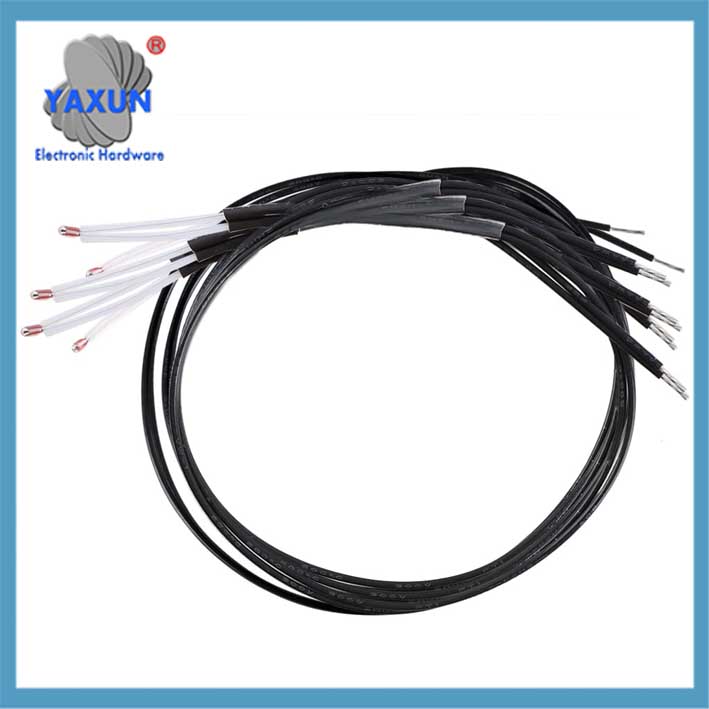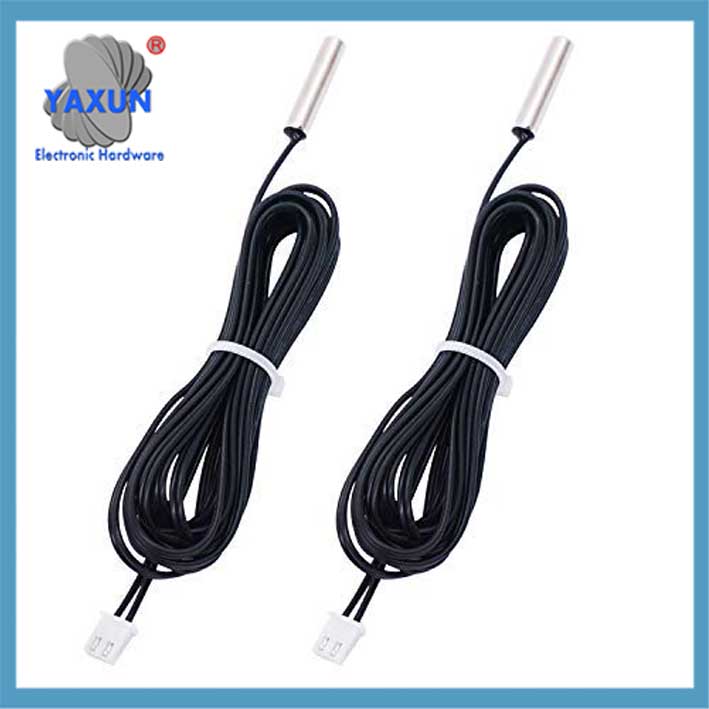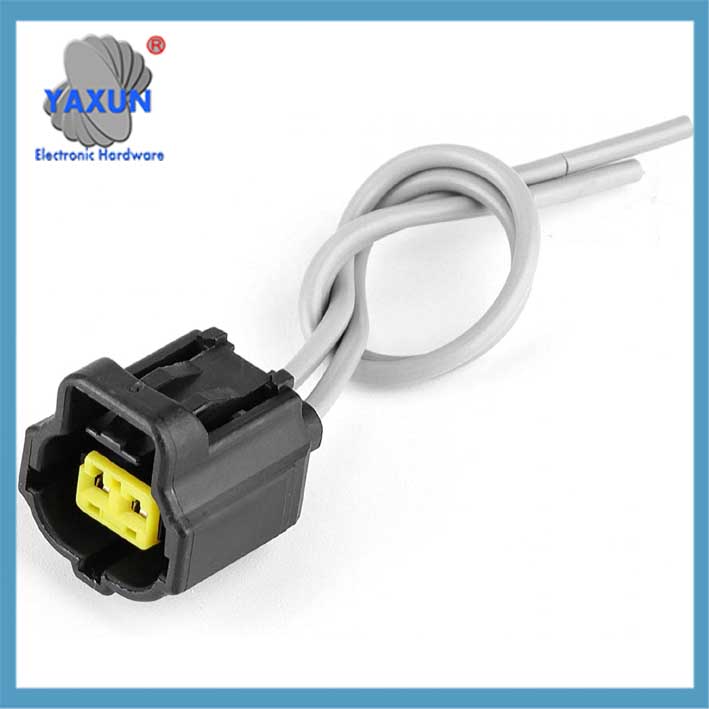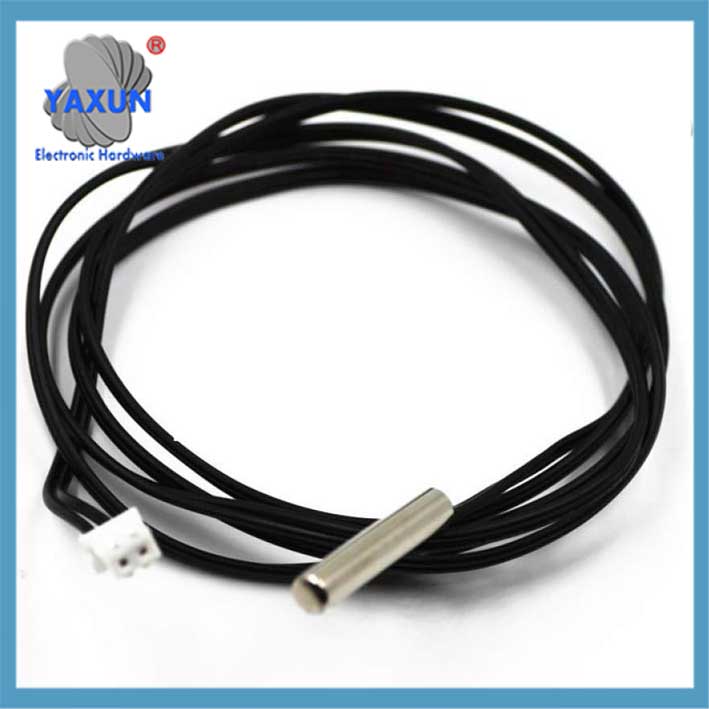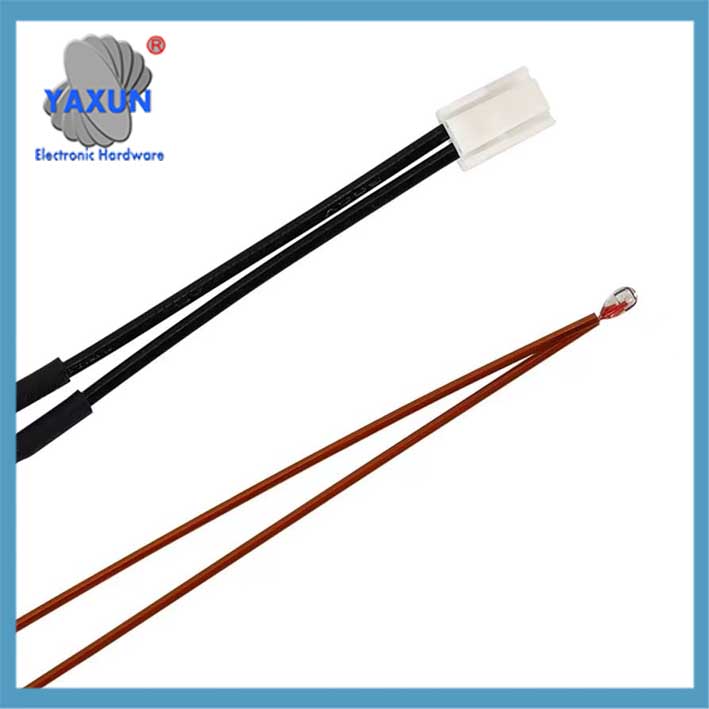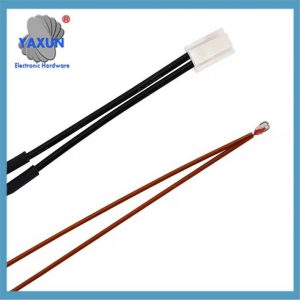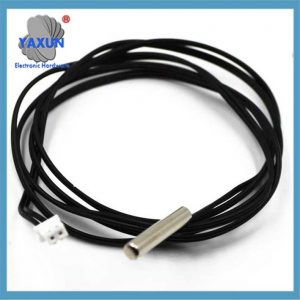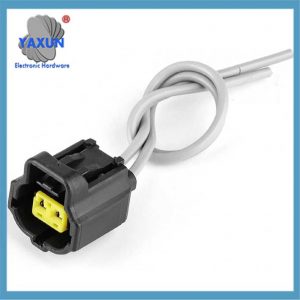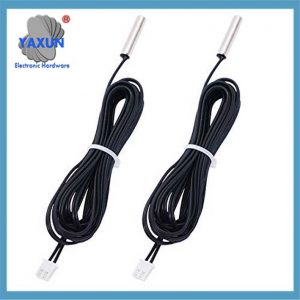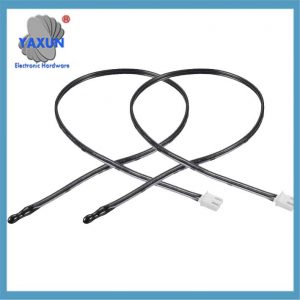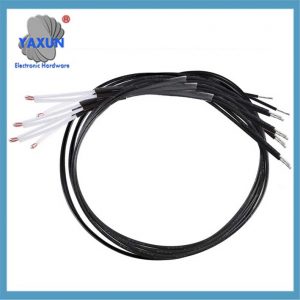Categorías de Producto
- fusible térmico 32
- fusibles de montaje en superficie 12
- termistor 36
- Portafusibles de montaje en PCB 27
- Arnés de cableado 6
- Portafusibles de cuchilla 17
- termostato 50
- Fusible eléctrico 24
- Sensor de temperatura automotriz 7
- Disyuntor térmico 22
- Portafusibles 36
- Sensor de temperatura 75
- Interruptor térmico 68
- Fusible del coche 20
- Fusibles atornillados 8
Etiquetas de productos
Arnés de alambre del sensor del termistor & Conjunto de cable
Es el sensor de tipo de montaje de la superficie fijado a los dispositivos con un tornillo de montaje de diferente tamaño requerido . Los productos pueden estar personalizados de acuerdo con diferentes temperaturas. Este es un solo (1) Arnés de alambre termistor o del ventilador. Medidas del arnés 36″ (914.4milímetros), 22 AWG. Puede elegir qué placa de circuito (Rambo, Mini-rambo,
Arnés de cableado del sensor de temperatura & Conjunto de cable para NTC, ptc. Los paquetes de sonda de temperatura común son: vaso, resina epoxídica, enhebrado, cerámico.
Los sensores de termistores son resistencias semiconductores sensibles al calor diseñadas para la medición y compensación de la temperatura. Su cartera cubre la serie NTC Termistor con excelente estabilidad a largo plazo en entornos de alta temperatura y alta humedad, tales como productos ultra pequeños para teléfonos inteligentes y terminales de tabletas, aplicaciones automotrices, Módulos LED, y aplicaciones industriales. Las tolerancias de alta precisión y los valores B dan a los termistores NTC Chip Capacidades de detección de temperatura extremadamente precisas.
Detección de temperatura del sustrato de flash LED basado en el arnés del sensor de termistores
El termistor NTC es un elemento de resistencia térmica cuya resistencia cae bruscamente a medida que aumenta la temperatura. Utilizando esta característica, Además de ser diseñado como sensor de temperatura, También se usa como elemento de protección de temperatura para evitar el sobrecalentamiento del circuito.
Instalando un termistor NTC cerca de la fuente de calor, La temperatura de la fuente de calor se puede detectar con precisión. Sin embargo, Debido a limitaciones como el tamaño del sustrato y el cableado de PCB, a veces es necesario instalarlo lejos de las fuentes de calor..
Asumimos esta situación, usó el LED en el sustrato de flash LED como fuente de calor, y confirmó la diferencia de temperatura medida debido a las diferentes posiciones de montaje del termistor LED y NTC a través de la simulación de calentamiento. Además, Se confirmó la influencia del grosor del sustrato y se explican los resultados.
Notas de aplicación
Manifestaciones de fallas y contramedidas de los termistores NTC en uso real
Un coeficiente de temperatura negativo (CNT) El termistor es una resistencia semiconductora cuya resistencia disminuye a medida que aumenta la temperatura, y la tasa de cambio en la resistencia es grande.
Tiene una amplia gama de aplicaciones, y sus usos principales incluyen la detección de temperatura en equipos electrónicos y compensación de temperatura en varias aplicaciones, como productos modulares.
Cuando se usa termistores NTC, Los usuarios deben asegurarse de que se usen correctamente.
El uso incorrecto puede dar como resultado que el producto no funcione a todo su potencial y, en el peor de los casos, mal funcionamiento.
A continuación enumeraremos dos manifestaciones de falla del termistor NTC causadas por un uso incorrecto, a saber, "grietas" y "derretimiento del sustrato".
Explicar las causas de la falla y proporcionar contramedidas correspondientes.
Características del tipo de producto:
Tipo de sensor: HVAC/R, Sensor de superficie
Características eléctricas:
Resistencia [KΩ] a 25 ° C (kΩ): 10
Valor beta (25/85) (k): 3976
Accesorios mecánicos:
Alambre/cubierta: 22 AWG ZIPCORD
Longitud de alambre: 3048 milímetros [120 en]
Entorno de uso:
Rango de temperatura de funcionamiento: -40 - 105 °C [ -40 - 221 °F ]
Temperatura de referencia de la resistencia: 25 °C [77 °F]
Precisión de la temperatura (°C): ± .2 (0 - 70), ± .2 (0 - 70)
Tolerancia a la resistencia (%): ± .88
Características de la sonda:
Sonda: Latón de níquel
Un termistor es una resistencia de sensor cuya resistencia cambia a medida que cambia la temperatura. De acuerdo con diferentes coeficientes de temperatura, se dividen en termistor de coeficiente de temperatura positiva (termistor PTC) y termistor de coeficiente de temperatura negativa (termistor NTC). El valor de resistencia de un termistor de coeficiente de temperatura positivo aumenta a medida que aumenta la temperatura, y el valor de resistencia de un termistor de coeficiente de temperatura negativa disminuye a medida que aumenta la temperatura. Ambos son dispositivos semiconductores.
Las principales características de los sensores de termistor son:
① Tiene alta sensibilidad, Su coeficiente de temperatura de resistencia es 10 a 100 veces mayores que el del metal, y puede detectar cambios de temperatura de 10-6 ° C;
② Rango de temperatura de funcionamiento amplio, Los dispositivos de temperatura normal son adecuados para -55 ℃~ 315 ℃, Los dispositivos de alta temperatura son adecuados para temperaturas superiores a 315 ℃ (Actualmente hasta 2000 ℃), y los dispositivos de baja temperatura son adecuados para -273 ℃~ -55 ℃;
③ Pequeño en tamaño, puede medir la temperatura de los huecos, Cavidades y vasos sanguíneos en organismos vivos que no pueden medir por otros termómetros;
④ Fácil de usar, el valor de resistencia se puede seleccionar de 0.1 a 100kΩ;
⑤ Fácil de procesar en formas complejas y se puede producir en grandes cantidades;
⑥ buena estabilidad y capacidad de sobrecarga fuerte.
Características básicas de los sensores de termistor
Las características de resistencia a la temperatura del sensor del termistor pueden expresarse aproximadamente por la siguiente fórmula: R = R0EXP{B (1/T-1/T0)}: R: valor de resistencia a temperatura t (k). RO: Valor de resistencia a la temperatura t0, (k) B: Valor b, *t(k)= t(ºC)+273.15. De hecho, El valor b del termistor no es constante, y su variación varía según la composición del material, e incluso puede alcanzar un máximo de 5k/° C. Por lo tanto, Al aplicar la ecuación 1 en un rango de temperatura más grande, Habrá un cierto error entre él y el valor medido real. Aquí, Si el valor b en la ecuación 1 se calcula como una función de la temperatura como se muestra en la ecuación 2, El error del valor medido real puede reducirse y puede considerarse aproximadamente igual.
BT = CT2+DT+E. En la fórmula anterior, do, D y E son constantes. Además, Las fluctuaciones en el valor B causadas por diferentes condiciones de producción harán que la constante E cambie, Pero las constantes C y D permanecen sin cambios. Por lo tanto, Al discutir la fluctuación del valor B, Solo la constante E necesita ser considerada. Cálculo de constantes c, D, y e. Constantes c, D, y E se puede calcular desde 4 puntos de (temperatura, valor de resistencia) datos (T0, R0). (T1, R1). (T2, R2) y (T3, R3), Calcular a través de ecuaciones 3 a 6. Primero, Encuentra B1, B2, y B3 basado en los valores de resistencia de T0 y T1, T2, y T3 del patrón 3, y luego sustituirlos en los siguientes patrones.
Ejemplo de cálculo del valor de resistencia: De acuerdo con la tabla característica de la temperatura de resistencia, Encuentre el valor de resistencia a 25 ° C 5 (kΩ). El valor de resistencia de un termistor con una desviación del valor B de 50 (k) Entre 10 ° C y 30 ° C. Paso (1) De acuerdo con la tabla característica de la temperatura de resistencia, Encuentra las constantes c, D, y e. A = 25+273.15t1 = 10+273.15t2 = 20+273.15t3 = 30+273.15
(2) Sustituye BT = CT2+DT+E+50 para encontrar BT.
(3) Sustituya el valor numérico en r = 5exp {(BT1/T-1/298.15)} para encontrar r. *t:10+273.15~ 30+273.15.
Hay muchos tipos de termistores. Infórmenos sobre los siguientes parámetros al ordenar:
| número de serie | Descripción de los parámetros a seleccionar | Recomendaciones de parámetros opcionales |
| 1 | Termistor R valor y valor B? | R25 comúnmente usado: 5KΩ/10kΩ/50 kΩ/100 kΩ |
| 2 | Elección de precisión? | ±1% |
| ±2% | ||
| ±5% | ||
| 3 | Rango de medición de temperatura? | -40~ 300 ℃ Opcional |
| 4 | Longitud de plomo? | 0.05m ~ 100m opcional |
| 5 | Formulario de embalaje de apariencia? | Dripper de agua/tubería recta/rosca/nariz de cobre/pegatina de superficie, etc.. |
| 6 | Cómo lidiar con el final de la línea? | Tark de lata/horno en forma de U/enchufe recto/aviación/conector impermeable/terminal, etc.. |
| 7 | Para otros requisitos no mencionados, Infórmenos en detalle. | |
Contáctenos
Esperando tu email, le responderemos dentro de 12 horas con la valiosa información que necesitabas.
 English
English Afrikaans
Afrikaans العربية
العربية বাংলা
বাংলা bosanski jezik
bosanski jezik Български
Български Català
Català 粤语
粤语 中文(简体)
中文(简体) 中文(漢字)
中文(漢字) Hrvatski
Hrvatski Čeština
Čeština Nederlands
Nederlands Eesti keel
Eesti keel Suomi
Suomi Français
Français Deutsch
Deutsch Ελληνικά
Ελληνικά हिन्दी; हिंदी
हिन्दी; हिंदी Magyar
Magyar Bahasa Indonesia
Bahasa Indonesia Italiano
Italiano 日本語
日本語 한국어
한국어 Latviešu valoda
Latviešu valoda Lietuvių kalba
Lietuvių kalba македонски јазик
македонски јазик Bahasa Melayu
Bahasa Melayu Norsk
Norsk پارسی
پارسی Polski
Polski Português
Português Română
Română Русский
Русский Cрпски језик
Cрпски језик Slovenčina
Slovenčina Slovenščina
Slovenščina Español
Español Svenska
Svenska ภาษาไทย
ภาษาไทย Türkçe
Türkçe Українська
Українська اردو
اردو Tiếng Việt
Tiếng Việt
